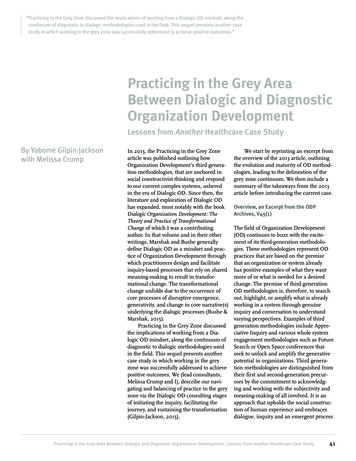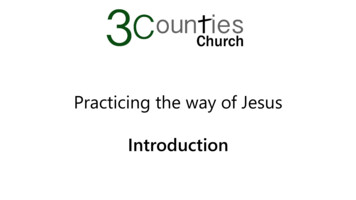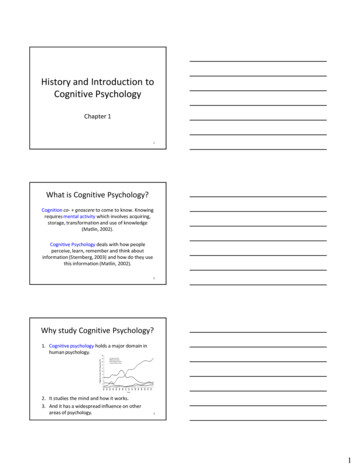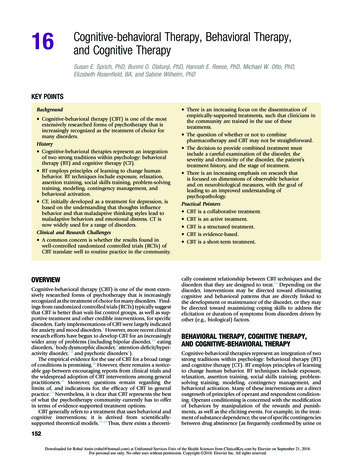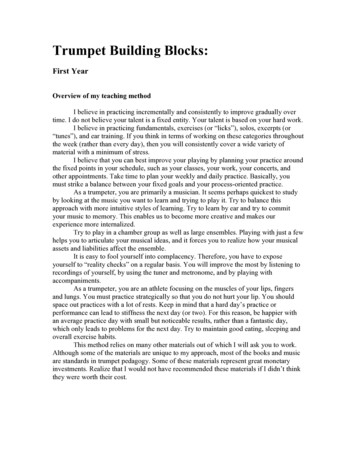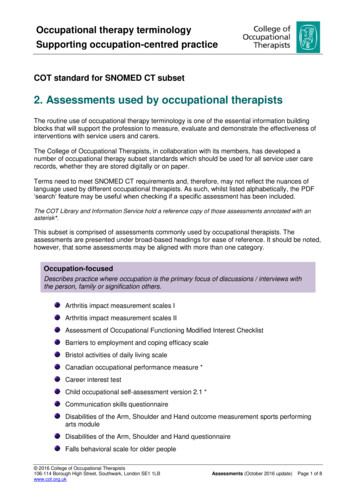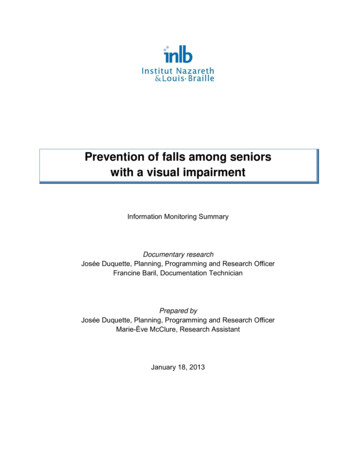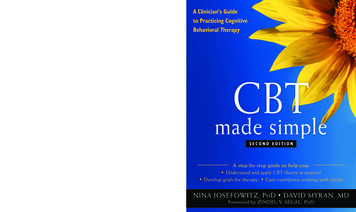
Transcription
PSYCHOLOGYCognitive behavioral therapy (CBT) is a highly effective, evidence-basedtreatment for mental health disorders. If you’re new to learningIncludesCBT, this simple and pragmatic guide offers everything you need toknow about this powerful modality: what it is, how it works, and howdownloadableto implement it in your sessions. And if you’re already practicingaudio exercisesCBT, this book will help sharpen your skills and increase youreffectiveness with clients.& sample clientand brain sciences atBoston UniversityNINA JOSEFOWITZ, PhD, is a psychologist who has taught CBT throughoutthe world. She currently teaches in the department of applied psychology and humandevelopment at the Ontario Institute for Studies in Education (OISE) of the Universityof Toronto.DAVID MYRAN, MD, FRCPC, (1949 – 2016) was a geriatric psychiatrist and formernewharbingerpublicationsw w w. n e w h a r b i n g e r . c o mJOSEFOWITZMYRANdirector of the Geriatric Psychiatry Outreach Team at Baycrest Health Sciences—a University of Toronto-affiliated hospital.SECONDEDITIONA Clinician’s Guide to PracticingCognitive Behavioral Therapysession videosThis fully revised and updated second edition provides a user-friendly,practical approach to mastering CBT using up-to-the-minute teachingmethods and learning tools. Each chapter presents key elements of CBTin clear, accessible language, and includes client dialogues and clinicalexamples. Exercises are incorporated throughout, enabling you to“Essential reading practice and consolidate your learning, and each chapter mimics thefor any practicingstructure of an actual CBT session. This new edition also includesclinician.”chapters on working with core beliefs and underlying assumptions,—Stefan G. Hofmann, PhD,as well as a new chapter on behavioral experiments—to make thisprofessor of psychology in thedepartment of psychologicala truly comprehensive CBT resource.CBT made simpleYour One-Stop Guide to Learning and Practicing CBTA Clinician’s Guideto Practicing CognitiveBehavioral TherapyCBTmade simpleSECOND EDITIONA step-by-step guide to help you: Understand and apply CBT theory in practice Develop goals for therapy Gain confidence working with clientsNINA JOSEFOWITZ, P h D DAVID MYRAN, MDForeword by ZINDEL V. SEGAL, P h D
“CBT Made Simple delivers a thorough, clear, and structured approach to learning cognitive behavioraltherapy (CBT) skills and applying them to clinical practice. Seasoned and new therapists will benefit fromthe written exercises, discussion of which interventions to use, and additional online resources to augmenttheir learning. I’m thrilled with the addition of mindfulness concepts in the second edition, which I’vefound add depth and efficacy to my own CBT practice.”—Sharon Martin, MSW, LCSW, psychotherapist,and author of The CBT Workbook for Perfectionism“The second edition of CBT Made Simple by Josefowitz and Myran is an updated version of their outstanding guide to the practice of CBT. This book is a rare example of a step-by-step manual that is user-friendly,case-based, engaging, and filled with useful tools and resources, including videos that can be accessedonline. The new edition has some excellent additions, including how mindfulness approaches can be usedto complement CBT.”—David K. Conn, MB, FRCPC, vice president of education at Baycrest Health Sciences,and professor in the department of psychiatry at the University of Toronto“The second edition of this extremely practical, helpful, and essential book on CBT is now even better thanits prior iteration. In a careful, emphatic, and clear manner, the reader is escorted through key principles.Especially exciting are new chapters on recognizing and dealing with old, long-standing core beliefs andhow to replace them, as well as dealing with underlying assumptions and behavioral experiments. Also,throughout the book there are now sections on how to incorporate mindfulness into CBT, helping clientsdecenter from their painful and habitual thoughts. Clinicians with all levels of sophistication and experience will find much to deepen their knowledge and practice. This volume is destined to be a classic.”—Michael Rosenbluth, MD, FRCPC, chief of the department of psychiatry at Michael GarronHospital, Toronto East Health Network; and associate professor at the University of Toronto“This second edition of CBT Made Simple retains all of what made the first edition such a great resource,and adds new material on working with core beliefs, mindfulness-based strategies, and case formulation. Asin the first edition, each chapter in this well-written book models the structure of a typical CBT session,including setting an agenda and completing practical exercises to build skills. I highly recommend thisupdated edition of CBT Made Simple, both for new clinicians and experienced therapists wanting to honetheir CBT skills!”—Martin M. Antony, PhD, professor of psychology at Ryerson University,and coauthor of The Shyness and Social Anxiety Workbook and The Anti-Anxiety Program
“CBT is arguably the most important nonmedical advancement in modern psychiatry. It has moved psychotherapy out of the Dark Ages to become a science-based approach that has alleviated the suffering of countlessof people inflicted by debilitating mental disorders. Still, very few clinicians today practice good (or any typeof) CBT, regardless of what they claim. This clinician’s guide for CBT by Josefowitz and Myran should be essential reading for any practicing clinician. I highly recommend this book.”—Stefan G. Hofmann, PhD, professor of psychology in the department of psychologicaland brain sciences at Boston UniversityPraise for the First Edition“Josefowitz and Myran have written a tremendously useful and practical book for new and seasoned practitioners alike. CBT Made Simple is accessible, engaging, and provides a wealth of clinical examples, resources, andapplications that will be turned to time and time again. The authors’ experience and wisdom shines through inproviding guidance to help the reader apply CBT not only to their clients, but to learn through applications onthemselves. Each chapter follows the structure of a CBT session, and guides the reader through learning in thesame way that they will teach their clients. CBT is made simple through this elegantly written book!”—Deborah Dobson, PhD, RPsych, adjunct professor in the department of psychology at theUniversity of Calgary, and coauthor of Evidence-Based Practice of Cognitive-Behavioral Therapy;and Keith Dobson, PhD, RPsych, professor of clinical psychology at the University of Calgary,and coeditor of Handbook of Cognitive-Behavioral Therapies“This book provides a clear and structured approach to learning and practicing CBT. Nina and David haveincorporated active learning strategies, visual and auditory techniques, and lots of opportunities to practicenew skills. In addition, a wealth of resources is available online to supplement the text. This book is an invaluable resource for therapists learning CBT for the first time, and for those more experienced who need a refresherin the core principles and practices of CBT.”—Enid Grant, MSW, RSW, senior director of children’s mental health at Skylark Children,Youth & Families
“Josefowitz and Myran’s innovative approach to teaching CBT skills engages the reader in a way that I haven’tseen in previous books on the topic. Each chapter of the book is organized like a CBT session—setting anagenda, presenting experiential exercises, and assigning homework. The book describes CBT in a step-by-step,accessible way that is sure to be helpful for both new therapists and seasoned clinicians wanting to brush up ontheir skills. I highly recommend CBT Made Simple!”—Martin M. Antony, PhD, professor of psychology at Ryerson University,and coauthor of The Shyness and Social Anxiety Workbook and The Anti-Anxiety Workbook“This is a program hidden in a book, which encourages an experiential approach to CBT learning. With theadditional web resources (videos, handouts) it will thoroughly engage CBT learners and teachers. A ‘must-have’text in the era of expanding CBT practice.”—Sanjay Rao, MD, clinical director of the mood and anxiety program at Royal Ottawa MentalHealth Centre, associate professor of psychiatry at the University of Ottawa, and executive memberof the Canadian Association of Cognitive Behavioural Therapies“Much has been written on CBT. Still there is a need—indeed a hunger—for a clear and practical how-to book.This volume fills that need remarkably well. Its pragmatic, skill-based, experiential approach will be extremelyhelpful—especially for clinicians new to CBT for whom it is intended. However, clinicians with all levels ofsophistication and experience will find much to deepen their knowledge and practice.”—Michael Rosenbluth, MD, FRCPC, chief of the department of psychiatry at Toronto EastGeneral Hospital, and associate professor at the University of Toronto“CBT Made Simple offers an innovative, cutting-edge method of understanding and using CBT using the effective adult learning model. This unique and practical resource will be of great help to clinicians who are new toCBT, as well as those who’ve been practicing for years. I highly recommend this book!”—Matthew McKay, PhD, psychologist; and coauthor of several books, includingThe CBT Anxiety Solution Workbook, Thoughts and Feelings, and Self-Esteem
The Made Simple SeriesWritten by leaders and researchers in their fields, the Made Simpleseries offers accessible, step-by-step guides for understandingand implementing a number of evidence-based modalities inclinical practice, such as acceptance and commitment therapy(ACT), dialectical behavior therapy (DBT), compassion-focusedtherapy (CFT), functional analytic psychotherapy (FAP), andother proven-effective therapies.For use by mental health professionals of any theoreticalbackground, these easy-to-use books break down complextherapeutic methods and put them into simple steps—givingclinicians everything they need to put theory into practice tobest benefit clients and create successful treatment outcomes.Visit www.newharbinger.com formore books in this series.
CBTmade simpleSECOND EDITIONA Clinician’s Guide to PracticingCognitive Behavioral TherapyNINA JOSEFOWITZ, P h DDAVID MYRAN, MDNew Harbinger Publications, Inc.
CHAPTER 10Behavioral Activation—Action Plans for DepressionIn the last chapter we covered problem solving. Did you notice your clients’ problem orientation? Did youhave a chance to try problem solving in your own life or with any clients? What was it like to consciouslyevaluate different solutions? Was it hard not to jump in and solve your clients’ problems?Set the AgendaIn this chapter you will learn how to help your clients who have depression by increasing their activity levelto improve their mood. The technical term for this intervention is behavioral activation.Agenda Item #1: Understand behavioral activation.Agenda Item #2: Help your clients understand their depression.Agenda Item #3: Monitor your clients’ daily activities.Agenda Item #4: Plan activities that increase positive moods.Agenda Item #5: Develop graded task assignments.Agenda Item #6: Increase well-being.Work the AgendaBehavioral activation is primarily a treatment for depression. It is based on the premise that when yourclients change their behaviors, and they increase activities that promote pleasure and a sense of competence, their mood will improve.Agenda Item #1: Understand Behavioral ActivationYou can think of depression as a cycle that is caused and maintained by avoidance and a lack of positivereinforcement. Depression starts with changes in a client’s life that lead to a decrease in events that they
195Behavioral Activation—Action Plans for Depression enjoy and an increase in unpleasant events. Thus your client’s overall mood declines, and activities theyused to enjoy are less pleasurable. Clients start avoiding activities such as seeing friends and family andpursuing hobbies, exercise, or leisure activities. The more clients avoid activities that might lift their mood,the less contact they have with positive reinforcements. The less contact with positive reinforcements, themore down they feel and the less they feel like doing anything (Martell, Dimidjian, & Herman-Dunn,2010).When clients become less active, their overall routine is disrupted, which may lead to sleep problems,poor appetite, and generally feeling out of sync with their environment, all of which exacerbate depression(Dimidjian, Barrera, Martell, Muñoz, & Lewinsohn, 2011). The more your clients are caught in this cycleof depression, the more they disengage from their normal life and the more likely they are to develop secondary problems. For example, the student who is too depressed to attend baseball practice may eventuallybe kicked off the team. Figure 10.1 shows how the cycle of depression works.Trigger: Difficult Situation or Life ChangesDecrease inpositive events;Increase innegative vitiesLow moodand fatigueThoughts: Idon’t enjoyanything; Iam tired andneed to rest.Figure 10.1. Cycle of depression.BREAKING THE CYCLE OF INACTIVITY AND DEPRESSIONBehavioral activation interrupts the cycle of depression by directly targeting avoidance and encouraging clients to engage in mood-boosting activities. Clients identify activities that (1) are enjoyable, (2)increase their confidence or sense of mastery, or (3) are functional in that they decrease the negative consequences of avoidance. The therapist works with clients to schedule these activities into their week, step
196 CBT Made Simpleby step, and uses the problem-solving process to address any obstacles (Martell et al., 2010). As clients startto engage in pleasurable activities, their mood improves. As clients feel better, they have more energy; theystop wanting to avoid activities, and they engage in healthy routines. In short, a mood-boosting cycle starts.Behavior al Activation TheoryPleasurable Activities Problem Solving Behavioral AntidepressantOVERVIEW OF BEHAVIORAL ACTIVATIONThe formal goal of behavioral activation is for your clients to return to their pre-depression level offunctioning. I prefer to tell my clients that our goal is to help them have a life they enjoy. The focus is toactively encourage clients to engage in activities even though they “feel” like avoiding or resting. It seemsto me that folk wisdom often captures the essence of behavioral activation. My Aunt Tanya, who is eightyeight, always told me, “No matter what, get up every morning and put on your makeup, and before you goto bed at night, have a sip of vodka.” In other words, according to Aunt Tanya, no matter how you arefeeling, get up and face the world, and before the day ends, do something nice for yourself.Generally, the behavioral activation process unfolds in the following order:1.Understand your client’s depression in relation to changes in their daily activities.2. Monitor your client’s daily activities.3.Plan activities that increase positive mood.4.Monitor your client’s mood before and after activities.5.Problem solve obstacles.6. Establish healthy routines and prevent setbacks.IS BEHAVIORAL ACTIVATION EFFECTIVE?Even though I have practiced behavioral activation for many years, when a client with severe depressioncomes into my office, I often find myself thinking that behavioral activation will not be enough. How canadding pleasurable activities be sufficient to help this very depressed client? But rather than believing myautomatic thoughts, I look at the evidence!Numerous studies, including a number of meta-analyses, have consistently demonstrated that behavioral activation is an effective treatment for mild, moderate, and severe depression. Group treatment is aseffective as individual treatment, and behavioral activation is as effective as antidepressant medication(Dimidjian et al., 2011; Ekers, Webster, Van Straten, et. al., 2014). Other meta-analyses indicate that behavioral activation significantly reduces depressive symptoms in geriatric populations (Orgeta, Brede, &Livingston, 2014) and that behavioral activation may be effective treatment for depression co-occurring
Behavioral Activation—Action Plans for Depression 197with substance abuse (Martinez-Vispo et. al., 2018); a systematic research review suggests that evidence isbeginning to show it is an effective treatment for depression in youth (Martin & Oliver, 2019).Behavioral activation alone has been found to be as effective as treatments that include both behavioral and cognitive interventions, such as identifying and challenging negative thoughts (Dimidjian et al.,2006; Richards et al., 2016). Behavioral activation is also an effective intervention for relapse prevention(Dobson et al., 2008). One study found that clients with complicated bereavement also responded positivelyto behavioral activation (Hershenberg, Paulson, Gros, & Acierno, 2014).Research SummaryClients with mild and moderate depression: Behavioral activation should be a component oftreatment.Clients with severe depression: Behavioral activation should be the first intervention.Agenda Item #2: Help Your Clients Understand Their DepressionA client who is depressed often starts therapy saying, “What is wrong with me? I used to be so strong”or “I think I am going crazy; I just feel like crying all day.” You want to help your client understand that theirdepression is related to a lack of mood-enhancing activities and is not a personal failure.You can use the cycle of depression as a model for gathering information that will help your clientsunderstand the factors that caused and maintain their depression. If a client understands that their depression is related to a lack of pleasurable activities in their life, they will be more motivated to engage in moodboosting activities. This is important, as you are going to ask your clients to engage in activities even if theydon’t “feel like it.”Start with looking at the changes in your client’s life that preceded their depression—in particular,decreases in reinforcing and/or pleasurable activities and increases in unpleasant activities. You also wantto look at how your client coped with these changes, and the role of avoidance. The two main questions Iask my client are:What life changes occurred prior to your depression?How did these changes affect your daily life activities in relation to an increase or decrease in pleasurable activities?SUZANNE’S CYCLE OF DEPRESSIONSuzanne started therapy saying she didn’t know what was wrong with her. She had a great house, greatkids, a good job, and a great husband, but she was just so overwhelmed that she didn’t enjoy life anymore.She cried softly as she told her therapist that she wasn’t coping.In chapter 2 we listed the stressors and recent changes in Suzanne’s life that happened prior to herdepression.
198 CBT Made Simple Suzanne started teaching at a new school. The school is a thirty- to forty-minute commute fromhome; she does not know the other teachers, who form a tight group. Her mother-in-law is no longer able to babysit. Genia, her best friend, moved away.Let’s see how her therapist uses the two questions we just identified to understand Suzanne’sdepression.Therapist:It sounds like there have been a lot of changes in your life. I am wondering if we could spenda moment and think about how each change has affected your life. Which one should we lookat first?Suzanne:Well, I think the really big one is the new school.Therapist:I think it would be helpful to look at how your life has changed since starting at the newschool. I want to look at activities you stopped doing and activities you started doing becauseof the new school.The therapist instills hope by starting with, “I think it would be helpful.” Notice her therapist did not ask Suzanne howshe feels about the new school. She asked her to look at how her life is different.Suzanne:One of the biggest changes is the morning. I used to walk to school; it was about fifteenminutes each way. I now spend forty-five minutes commuting. The extra thirty minutes I usedto have meant that I had time to get the kids ready in the morning. Now everything has to beready the night before. The kids have to be completely ready to be dropped off at my neighbor’shome by 7:30. It’s really hard getting them up, dressed, and fed. My neighbor takes them toschool. My husband leaves early for work and can’t help.Therapist:That sounds like a really big change to your morning routine.Suzanne:Yes, I used to enjoy the mornings—it was a nice time with the kids, and I liked the walk toschool. Now it is just so stressful.The therapist makes a supportive comment, and Suzanne goes on to elaborate how her life has changed.Therapist:I want to start making a list of the ways your life has changed. I think it will help us understandyour depression and how to help you. What would you put down?Notice how her therapist instills hope. The therapist asks Suzanne what she would put on the list.Suzanne:Well, I guess, I no longer have the fifteen-minute walk to school, I no longer have a nice timewith my kids in the morning, and actually, I rarely eat breakfast, I am so frazzled. I am oftenstarving by the time I get to school.Therapist:I think that’s a really good list of all the things that you are no longer doing. What about anything that you now do because of the new school that you were not doing before?Suzanne:Well, I guess I have to be really organized the night before, which I find hard. I make mydaughter’s lunch, put out the kids’ clothes, and make sure I am all organized for school. Also,I have to be really strict with the kids, as I am on a tight schedule. Which means I yell more to
Behavioral Activation—Action Plans for Depression 199get them going in the morning. I also have the long drive to work, which I hate. I spend thewhole time in the car thinking about what a bad mom I’ve become, how I yelled at the kidsonce again, and how I wish I were back at my old school. It’s just awful.Therapist:Sounds like a lot of changes. When we look at how different your morning is now from how itused to be, what are your thoughts?Note that the therapist first asked Suzanne what had changed; second, she asked her how the change had affected herdaily life; and third, she asked her what she thought when she looked at the changes.Suzanne:Well, no wonder I am depressed; it sounds like an awful way to start the morning.By examining how her morning has changed, Suzanne has shifted from “something is wrong with me that I am depressed”to realizing that the changes in her morning routine may be contributing to her depression.Therapist:I think you said something important. Seems like the change in school caused a lot of otherchanges in your life and had a negative effect on your morning routine and mood. I think weare discovering some important information. I want to see if there are other ways that startingat the new school has impacted your life.Notice how Suzanne’s therapist reinforces her awareness that her morning routine is impacting her mood. Also noticehow the therapist keeps Suzanne on track with the task.Suzanne used to spend time with other teachers, who were her friends, and now she sees few of herfriends. She had enjoyed being involved in the school play and had received a lot of positive feedback. Shewas well known as a popular teacher. At her new school she participates in no extracurricular activities andknows none of the other teachers socially. She gets home from work late, tired and frazzled from the drive.Suzanne had not realized that since her mother-in-law had become ill and could no longer babysit, sheand her husband had practically stopped going out in the evening. It had been ages since they had seenmany of their friends. Suzanne also realized that since Genia had moved away, she had stopped their weeklywalks and talked to her friend much less. Suzanne was surprised when she looked at the impact of all thechanges in her life. Exercise 10.1: Raoul’s Cycle of DepressionPractice using the cycle of depression to understand your clients.USE A WRITTEN SUMMARYAfter I have explored with my client how her life has changed, I find it helpful to provide a writtensummary. Sometimes I draw the cycle of depression, and together we look at how it is related to my client’sspecific situation. Other times I use the Understand Your Depression worksheet, which you can downloadat http://www.newharbinger.com/44550. When Suzanne looked at her Understand Your Depression worksheet, it made sense that the changes in her activities were affecting her depression.
200 CBT Made SimpleUnderstand Your DepressionChanges or stressors in your life prior to your depression? New school, mother-in-law no longerbabysitting, and Genia, her best friend, moving away.Since these changes or stressors, how have your activities changed? Complete this form.Increased Since Life Changes orStressorsDecreased Since Life Changes orStressorsActivities I enjoy orthat provide pleasureor masteryNoneWalk to school; nice time with childrenin the morning; going out with husbandand seeing friends; Sunday walk withGenia; talking to GeniaActivities I do notenjoyGetting ready the night before;long drive to work; getting upearly and getting children readyNoneExerciseNo walk to school, no Sunday walkSpending time withfriendsStopped seeing school friends, Geniamoved awaySpending time withfamilySee mother-in-law more, as shehas been illLess time with children in the morning;less time with husband overallLeisure or hobbiesNoneNo school play; no other extracurricularactivitiesSmoking, overeating,alcohol or drug useNoneRoutines related toeating and sleepingNo breakfast routine, often fall asleep infront of TVUSE AN ANALOGYI sometimes use a flower analogy to help my client understand their depression. This analogy wasinspired by Melanie Fennell’s virtuous and vicious flowers (Fennell, 2006). I explain that feeling happy issimilar to a brightly colored flower with lots of petals. I then draw a flower with a circle in the middle andpetals around the circle. I ask my client to fill in each petal with an activity she did before she becamedepressed that she enjoyed or gave meaning to her life. I look for healthy routines; social activities with colleagues, friends, and family; activities that are pleasurable or meaningful; and activities that lead to a senseof competence or mastery.
Behavioral Activation—Action Plans for Depression 201Once my client has completed filling in her flower, I ask her to draw an X through all the petals thathave changed since the depression. Usually, almost all of them are gone. What was once a full bloom isoften only a few petals.With some clients, instead of a flower I draw a picture of a wall. I use bricks to build a strong wall; if youtake out too many bricks, the wall will fall or have big holes.Suzanne’s therapist used the flower analogy, and Suzanne was surprised to see her flower. Her depression was making more and more sense to her. Her therapist explained that together they would help Suzannestart to add petals back into her life so that she could start to feel better. Suzanne said this was a good idea,but added that she couldn’t imagine where to begin. Her therapist assured her they would work together andgo slowly.Your Turn!Understand Mayleen’s DepressionMayleen, a fifty-eight-year-old woman, started therapy because she is currently depressed. Try to completethe Understand Your Depression worksheet with the information provided. You can see my answers in theappendix.Mayleen is a successful sculptor. She lives alone, has never married, and has no children. Two years agoher mother became ill, and Mayleen has been very involved in her care.Mayleen’s mother lives alone about a three-hour drive away. Mayleen has no other friends or family wholive there. She spends four days a week visiting her mother and attending to her needs, looking after thehouse, and taking her to doctor’s appointments. Mayleen is happy that she is able to care for her sick motherbut feels lonely when she visits. She and her mother watch a lot of daytime TV, which Mayleen finds boring.Over the two years that her mother has been ill, Mayleen has become increasingly depressed and feelsguilty about not spending all her time caring for her mother. She has stopped seeing many of her friends,has given up exercise, and has almost completely stopped sculpting, as she believes there is no time for theseactivities, and she is so tired most of the time.Video 10.1: Explain DepressionAgenda Item #3: Monitor Your Clients’ Daily ActivitiesBehavioral activation involves asking your clients to engage in pleasurable activities. Sounds easy. Thedifficulty is that depressed clients don’t feel like doing anything. They will tell you, “Nothing helps.” You aregoing to ask your clients to act according to a plan rather than according to how they feel. If your clientscan see the connection between an increase in their activity level and an increase in their mood, they willbe more motivated to add pleasurable activities to their lives, even if they don’t “feel” like doing them.The easiest way for clients to see the connection between their mood and specific activities is tomonitor their daily activities and rate their moods. I ask clients to complete a Daily Activities Schedule(available at http://www.newharbinger.com/44550), where they write what they do, hour by hour, and rate
202 CBT Made Simpletheir mood. I usually complete the first day of the Daily Activities Schedule during the therapy hour. Thatway, I am sure my client understands what to do. (If the session is early in the morning, we complete it forthe previous day.) Then for homework I assign the Daily Activities Schedule for the rest of the week.Here is how I introduce the D
University of Calgary, and coauthor of Evidence-Based Practice of Cognitive-Behavioral Therapy; and Keith Dobson, PhD, RPsych, professor of clinical psychology at the University of Calgary, and coeditor of Handbook of Cognitive-Behavioral Therapies “This book provides a clea

